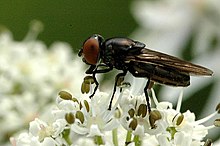The Brachyopini (or Chrysogastrini) is a tribe of hoverflies. Unlike many members of this family these flies are generally darker and less colourful though some genera contain species with an attractive metallic lustre e.g. Chrysogaster. Some like Brachyopa are associated with sap runs where their larvae feed on decaying sap. Others are found in boggy areas where their often semiaquatic larvae feed on decaying organic matter.[1]
| Brachyopini | |
|---|---|

| |
| Chrysogaster solstitialis | |
| Scientific classification | |
| Domain: | Eukaryota |
| Kingdom: | Animalia |
| Phylum: | Arthropoda |
| Class: | Insecta |
| Order: | Diptera |
| Family: | Syrphidae |
| Subfamily: | Eristalinae |
| Tribe: | Brachyopini |
| Genera | |
|
See text | |
List of genera
editSubtribe: Brachyopina
- Brachyopa Meigen, 1822[2]
- Cacoceria Hull, 1936[3]
- Chromocheilosia Hull, 1950[4]
- Chrysogaster Meigen, 1803[5]
- Chrysosyrphus Sedman, 1965
- Cyphipelta Bigot, 1859
- Hammerschmidtia Fallén, 1817
- Hemilampra Macquart, 1850
- Lejogaster Rondani, 1857
- Lepidomyia Loew, 1864
- Liochrysogaster Stackelberg, 1924
- Melanogaster Rondani, 1857
- Myolepta Loew, 1864
- Orthonevra Macquart, 1829
- Riponnensia Maibach, 1994
Subtribe: Spheginina
- Austroascia Thompson & Marnef, 1977[6]
- Chamaesphegina Shannon & Aubertin, 1933[7]
- Neoascia Williston, 1887[8]
- Sphegina Meigen, 1822[2]
References
edit- ^ Stubbs, Alan E.; Falk, Steven J. (1983). British Hoverflies: An Illustrated Identification Guide (2nd ed.). British Entomological & Natural History Society. pp. 268–283. ISBN 1-899935-03-7.
- ^ a b Meigen, Johann Wilhelm (1822). Systematische Beschreibung der bekannten europäische n zweiflugeligen Insekten. Hamm: Dritter Theil. Schulz-Wundermann. pp. x, 416, pls. 22–32. Retrieved 14 April 2019.
- ^ Hull, F.M. (1936). "Change of name (Diptera: Syrphidae)". Entomological News. 47: 227. Retrieved 14 November 2021.
- ^ Hull, Frank Montgomery; Fluke, Charles Lewis Jr. (1950). "The genus Cheilosia Meigen (Diptera, Syrphidae). The subgenera Cheilosia and Hiatomyia" (PDF). Bulletin of the American Museum of Natural History. 94. American Museum of Natural History: 299–402. Archived from the original (PDF) on 2015-01-04. Retrieved 3 January 2015.
- ^ Meigen, J. W. (1803). "Versuch einer neuen Gattungs-Eintheilung der europaischen zweiflugligen Insekten". Mag. Insektenkd. 2: 259–281.
- ^ Thompson, F.C.; Marnef, L. (1977). "Austroascia segersi, a new genus and species (Diptera: Syrphidae)" (PDF). Papéis Avulsos de Zoologia. 31: 1–6. Archived from the original (PDF) on 2012-06-05. Retrieved 2011-12-28.
- ^ Shannon, Raymond C.; Aubertin, D. (1933). Syrphidae. Diptera Patagonia & South Chile. Vol. 4. London: The Trustees of the British Museum. pp. 120–170.
- ^ Williston, Samuel Wendell (1887). "Synopsis of the North American Syrphidae". Bulletin of the United States National Museum. 31. United States National Museum: xxx + 335. doi:10.5479/si.03629236.31.i. Retrieved 3 January 2015.
Bibliography
edit- BioSystematic Database of World Diptera [1]